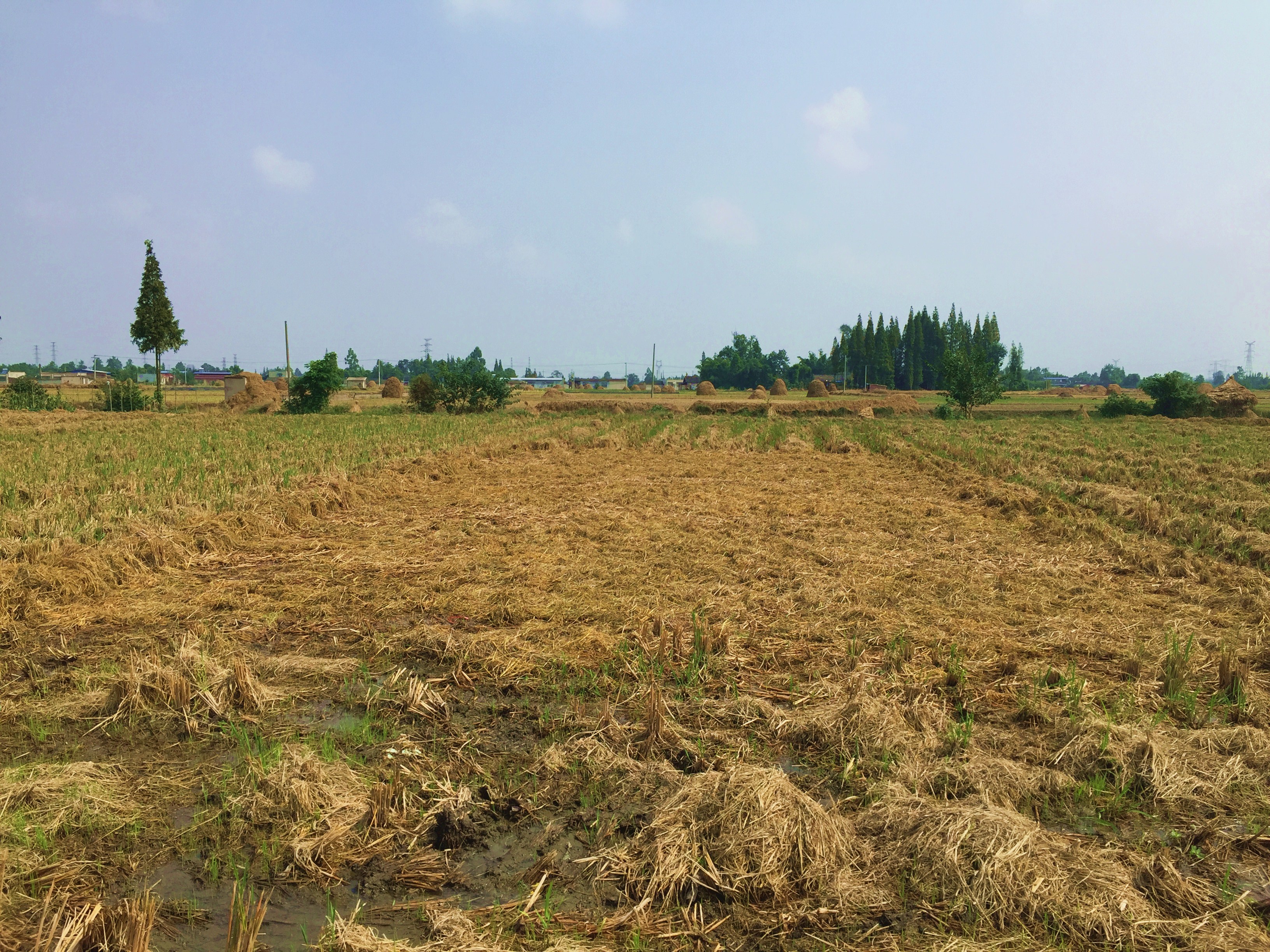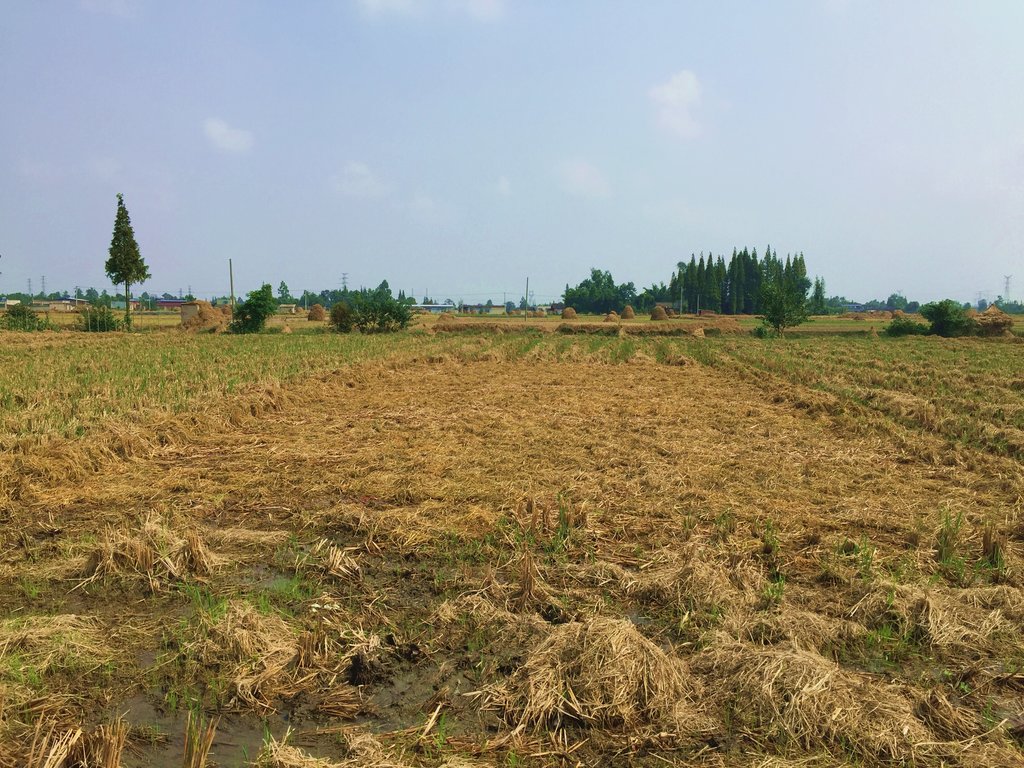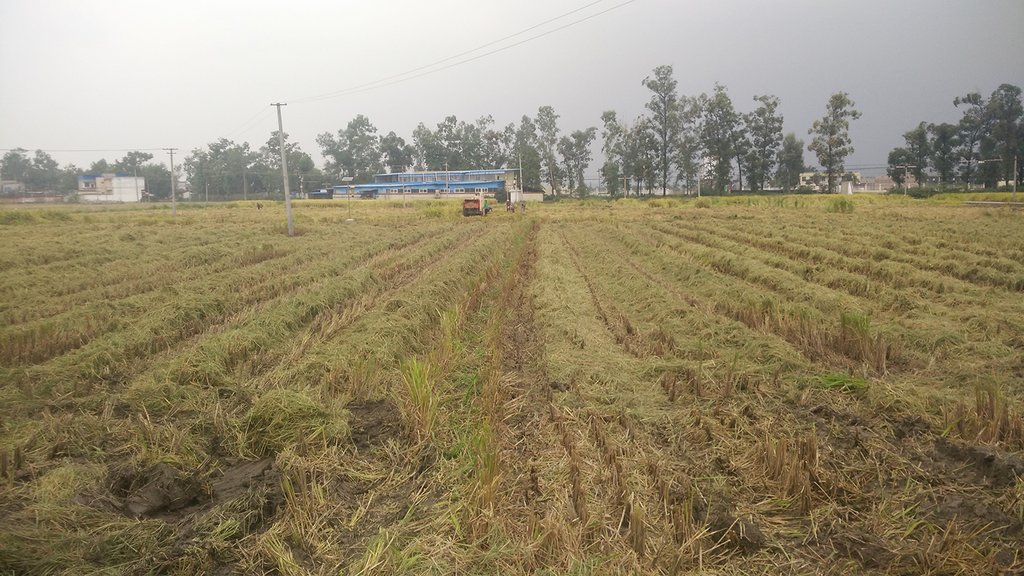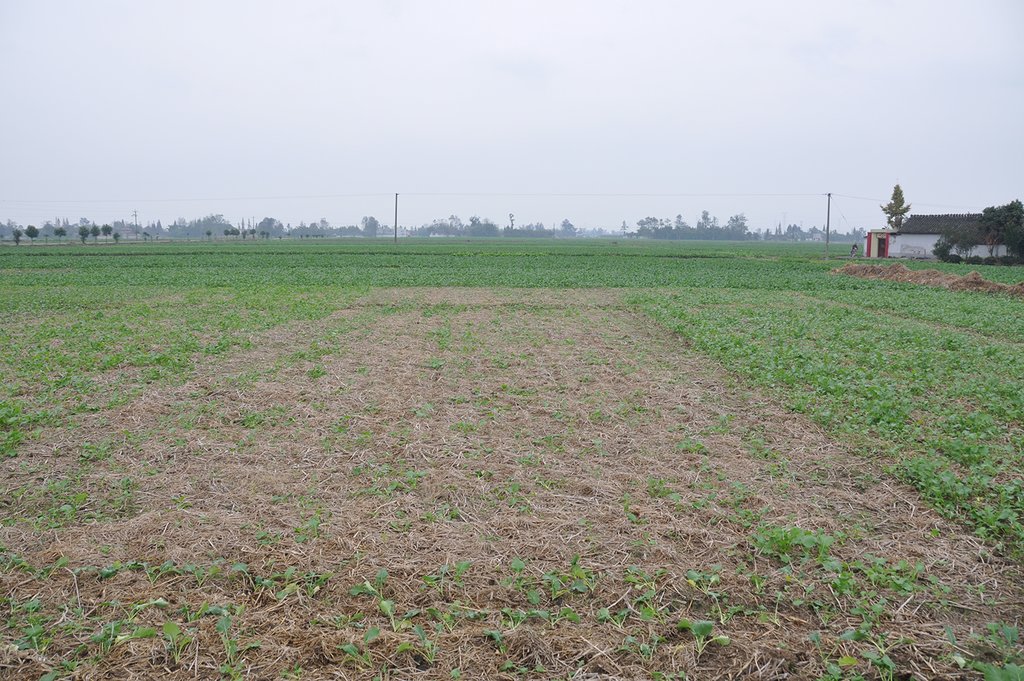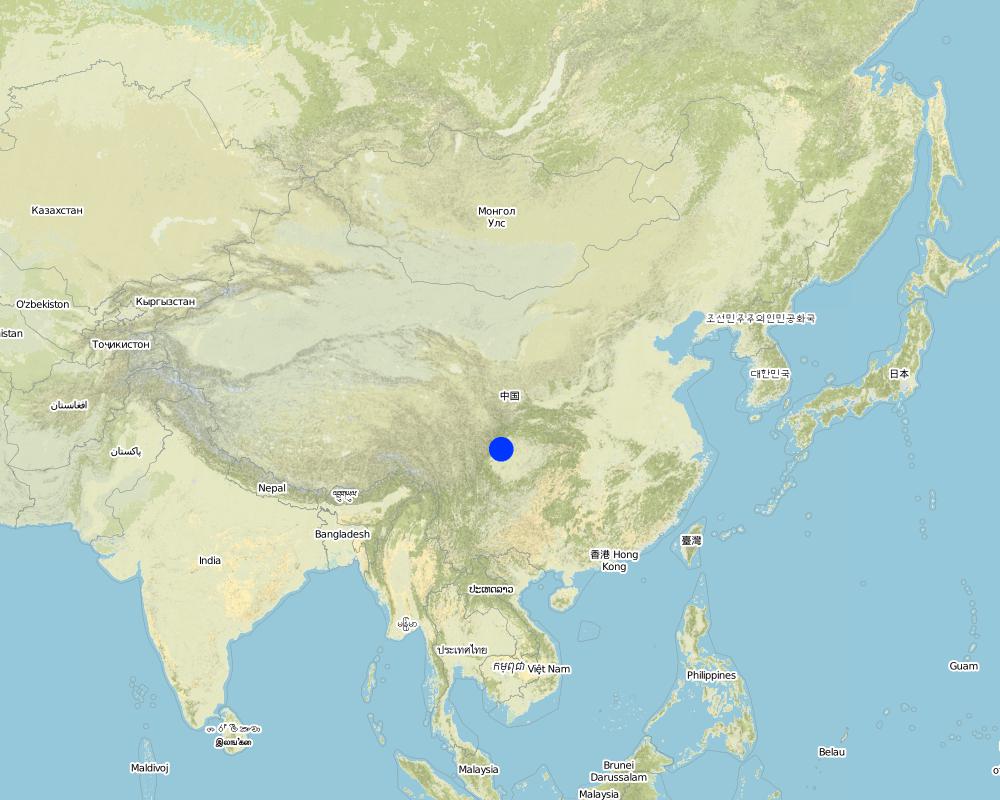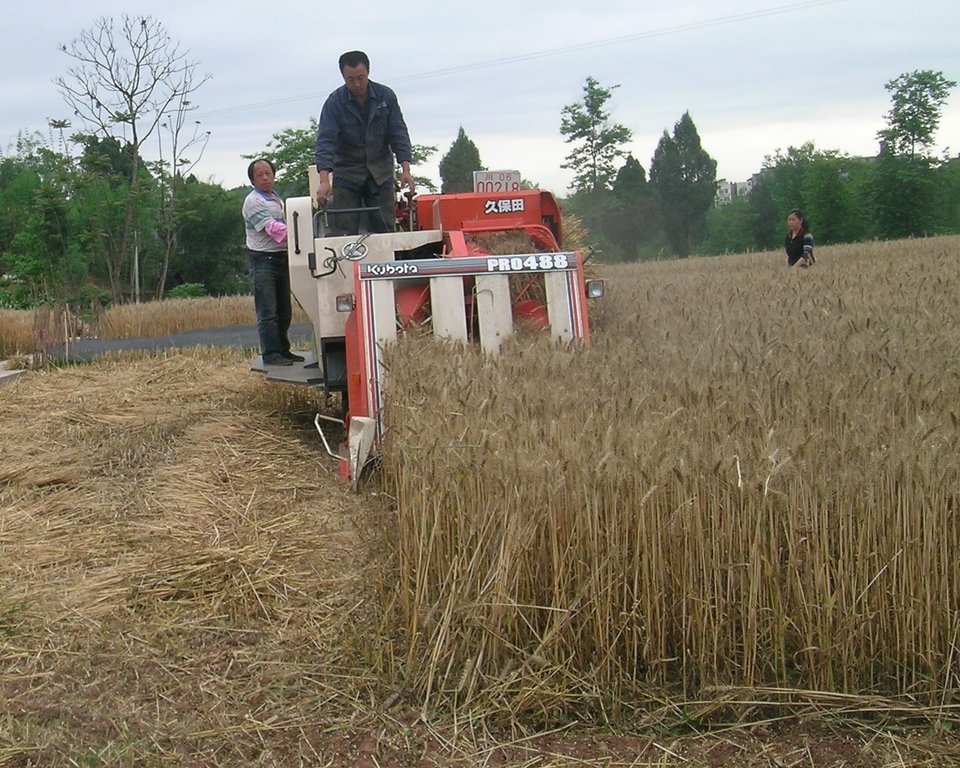Straw residues left on field after harvest and no tillage [จีน]
- ผู้สร้างสรรค์:
- การอัพเดท:
- ผู้รวบรวม: Song Guo
- ผู้เรียบเรียง: –
- ผู้ตรวจสอบ: Gudrun Schwilch, Ursula Gaemperli, Alexandra Gavilano
No tillage planting
technologies_3239 - จีน
ดูส่วนย่อย
ขยายทั้งหมด ย่อทั้งหมด1. ข้อมูลทั่วไป
1.2 รายละเอียดที่ติดต่อได้ของผู้รวบรวมและองค์กรที่เกี่ยวข้องในการประเมินและการจัดเตรียมทำเอกสารของเทคโนโลยี
วิทยากรหลัก
ผู้เชี่ยวชาญ SLM:
Hongzhu Fan
Soil and Fertilizer Institute of the Sichuan Academy of Agricultural Sciences
จีน
ผู้ใช้ที่ดิน:
Wu Shengde
จีน
ชื่อของโครงการซึ่งอำนวยความสะดวกในการทำเอกสารหรือการประเมินเทคโนโลยี (ถ้าเกี่ยวข้อง)
Interactive Soil Quality assessment in Europe and China for Agricultural productivity and Environmental Resilience (EU-iSQAPER)ชื่อขององค์กรซึ่งอำนวยความสะดวกในการทำเอกสารหรือการประเมินเทคโนโลยี (ถ้าเกี่ยวข้อง)
‒ Soil and Fertilizer Institute of the Sichuan Academy of Agricultural Sciences (SFI) - จีน1.3 เงื่อนไขการใช้ข้อมูลที่ได้บันทึกผ่านทาง WOCAT
ผู้รวบรวมและวิทยากรหลักยอมรับเงื่อนไขเกี่ยวกับการใช้ข้อมูลที่ถูกบันทึกผ่านทาง WOCAT:
ใช่
1.4 การเปิดเผยเรื่องความยั่งยืนของเทคโนโลยีที่ได้อธิบายไว้
เทคโนโลยีที่ได้อธิบายไว้นี้เป็นปัญหาของความเสื่อมโทรมโทรมของที่ดินหรือไม่ จึงไม่ได้รับการยอมรับว่าเป็นเทคโนโลยีเพื่อการจัดการที่ดินอย่างยั่งยืน:
ไม่ใช่
2. การอธิบายลักษณะของเทคโนโลยี SLM
2.1 การอธิบายแบบสั้น ๆ ของเทคโนโลยี
คำจำกัดความของเทคโนโลยี:
Method of this agricultual technology the rice straw will be left on the field after mechanized harvesting. Succession crop, such as rape, wheat or potato, were seeded directly under no tillage condition. Both measures aim at better soil regeneration and soil conditions for agriculture and subsequently increased yield and less soil degradation.
2.2 การอธิบายแบบละเอียดของเทคโนโลยี
คำอธิบาย:
The SLM practice (straw mulching and no tillage) is applied in the Chengdu Plain Paddy Soil. The Chengdu plain has mild climate and abundant rainfall. It belongs to the warm humid subtropical Pacific monsoon climate zone.The main types of soil in the Chengdu plain are paddy soil and purple soil.The total land resources of the Chengdu plain are 1331800 hectares, and the per capita land resources are about 0.1044 hectares per person. In 2010, the total amount of cultivated land in the Chengdu plain was 478069 hectares, accounting for 35.90% of the area of the plain, accounting for 42.36% of the total area of agricultural land in the region, and the per capita arable land area was only about 0.0375 hectares. The Chengdu Plain is an important grain production base in Sichuan. Rice field-upland field rotation (rice - wheat, rice - rapeseed) is an important agricultural system.
On the case study area, the N, P and K fertilizers were applied as urea, calcium superphosphate and potassium chloride at the rates of 120-150 kg N ha-1, 75-120 kg P2O5 ha-1,and 75-120 kg K2O ha-1, during every crop. During crop season, the rate of 60% of N, 100% of P, and 50% of K fertilizers were applied as base fertilizer, while remaining 40% of N and 50% of K were used as top dressing fertilizer. The main measures of this SLM is rice straw or wheat straw mulching while havesting (leaving the straw after havest scattered on the field). Crops were harvested by a combine harvester (Kuotian combine harvester, model PR0488), then straw and stubble of crops were left at size of less than 20 cm in the field. The seeding of succession crop such as wheat and oil seed rape is done by a direct seeding machine. The land users are working eighter with a contractor or they use their own machines and labour force. The purposes of this technology were to increase production and improve soil fertility. Although plough layer can become shallow by long-term no tillage cultivation, more and more land users like this technology because it promises increased grain yield, reduction of fertilizers (and subsequently cost), and it improves soil physical, chemical and biological properties of soil. Thus, it is expected that the measures of this SLM-Technology ends up in improved soil moisture, higher diversity of soil life and finally soil fertility .
2.3 รูปภาพของเทคโนโลยี
2.5 ประเทศภูมิภาค หรือสถานที่ตั้งที่เทคโนโลยีได้นำไปใช้และได้รับการครอบคลุมโดยการประเมินนี้
ประเทศ:
จีน
ภูมิภาค/รัฐ/จังหวัด:
Basin plain, Chengdu, Sichuan
ข้อมูลจำเพาะเพิ่มเติมของสถานที่ตั้ง :
Guanhan City, Wenjiang District, Chongzhou City
ระบุการกระจายตัวของเทคโนโลยี:
- กระจายไปอย่างสม่ำเสมอในพื้นที่
If precise area is not known, indicate approximate area covered:
- 100-1,000 ตร.กม.
แสดงความคิดเห็น:
This long-term straw mulch experiment was started in the 2005. This site is situated in subtropical monsoon region with anverage annual temperature of about 16.3℃, 281 days frost free. Annual precipitation is about 890mm.
Map
×2.6 วันที่การดำเนินการ
ถ้าไม่รู้ปีที่แน่นอน ให้ระบุวันที่โดยประมาณ:
- 10-50 ปี
2.7 คำแนะนำของเทคโนโลยี
ให้ระบุว่าเทคโนโลยีถูกแนะนำเข้ามาอย่างไร:
- ในช่วงการทดลองหรือการทำวิจัย
ความคิดเห็น (ประเภทของโครงการ เป็นต้น) :
The current case study bases only on a test area within the scope of the iSQAPER Project. A long-term straw mulch and fertilization experiment was initiated in 2005 at Sichuan Academy of Agricultural Sciences Soil and Fertilizer Research Institute’s Guanghan agricultural experiment station in Sichuan province, southwest China. Thus, effects of long-term fertilization and straw much on crop yields, soil physical and chemical properties under rice-rapeseed rotation were assessed in a paddy soil
3. การจัดประเภทของเทคโนโลยี SLM
3.1 วัตถุประสงค์หลักของเทคโนโลยี
- ปรับปรุงการผลิตให้ดีขึ้น
- ลด ป้องกัน ฟื้นฟู การเสื่อมโทรมของที่ดิน
- อนุรักษ์ระบบนิเวศน์
- รักษาสภาพหรือปรับปรุงความหลากหลายทางชีวภาพ
3.2 ประเภทของการใช้ที่ดินในปัจจุบันที่ได้นำเทคโนโลยีไปใช้

พื้นที่ปลูกพืช
- การปลูกพืชล้มลุกอายุปีเดียว
Annual cropping - Specify crops:
- oilseed crops - sunflower, rapeseed, other
- wheat, rice
จำนวนของฤดูเพาะปลูกต่อปี:
- 2
Is crop rotation practiced?
ใช่
ถ้าใช่ ระบุ:
Method of this agricultual technology the rice straw will be left on the field after mechanized harvesting. Succession crop, such as rape, wheat or potato, were seeded directly under no tillage condition.
3.4 การใช้น้ำ
การใช้น้ำของที่ดินที่มีการใช้เทคโนโลยีอยู่:
- น้ำฝนร่วมกับการชลประทาน
3.5 กลุ่ม SLM ที่ตรงกับเทคโนโลยีนี้
- ระบบหมุนเวียน (การปลูกพืชหมุนเวียน การพักดิน การเกษตรแบบไร่เลื่อนลอย)
- การปรับปรุงดิน / พืชคลุมดิน
- การรบกวนดินให้น้อยที่สุด
3.6 มาตรการ SLM ที่ประกอบกันเป็นเทคโนโลยี

มาตรการจัดการพืช
- A1: พืช/สิ่งปกคลุมดิน
- A2: อินทรียวัตถุในดิน/ความอุดมสมบูรณ์ในดิน
- A3: การรักษาหน้าดิน
3.7 รูปแบบหลักของการเสื่อมโทรมของที่ดินที่ได้รับการแก้ไขโดยเทคโนโลยี

การเสื่อมโทรมของดินทางด้านเคมี
- Cn (Fertility decline): ความอุดมสมบูรณ์และปริมาณอินทรียวัตถุในดินถูกทำให้ลดลงไป (ไม่ได้เกิดจากสาเหตุการกัดกร่อน)

การเสื่อมโทรมของดินทางด้านกายภาพ
- Pc (Compaction): การอัดแน่น
- Pk (Slaking and crusting): การอุดตันของช่องว่างในดินหรือรูพรุน
3.8 การป้องกัน การลดลง หรือการฟื้นฟูความเสื่อมโทรมของที่ดิน
ระบุเป้าหมายของเทคโนโลยีกับความเสื่อมโทรมของที่ดิน:
- ป้องกันความเสื่อมโทรมของที่ดิน
4. ข้อมูลจำเพาะด้านเทคนิค กิจกรรมการนำไปปฏิบัติใช้ ปัจจัยนำเข้า และค่าใช้จ่าย
4.1 แบบแปลนทางเทคนิคของเทคโนโลยี
ข้อมูลจำเพาะด้านเทคนิค (แบบแปลนทางเทคนิคของเทคโนโลยี):
The SLM practice (straw mulching while harvesting and no tillage) is applied in the Chengdu Plain paddy soil. The main measures of this SLM method is straw mulching while harvesting and no tillage. Crops are harvested by machine (actually in this case study by Kuotian combine harvester/model was PR0488), and then straw and stubble were left at size of less than 20 cm on the soil surface. The N, P and K fertilizers to the succession crop were applied in form of urea, calcium superphosphate and potassium chloride at the rates of 120-150 kg N ha-1, 75-120 kg P2O5 ha-1, and 75-120 kg K2O ha-1. Rates of 60% of N, 100% of P and 50% of K fertilizers were applied as base fertilizers, while the remaining 40% of N and 50% of K were used as top dressing fertilizers. After previous crop harvest of rice the succession crop as for example wheat, oil rape, maize will be seeded directly under no tillage condition.
ผู้เขียน:
Hongzhu Fan
วันที่:
30/10/2017
4.2 ข้อมูลทั่วไปเกี่ยวกับการคำนวณปัจจัยนำเข้าและค่าใช้จ่าย
ให้ระบุว่าค่าใช้จ่ายและปัจจัยนำเข้าได้รับการคำนวณอย่างไร:
- ต่อพื้นที่ที่ใช้เทคโนโลยี
ระบุขนาดและหน่วยพื้นที่:
1 hectare
อื่นๆ หรือสกุลเงินประจำชาติ (ระบุ):
Renminbi (RMB)
If relevant, indicate exchange rate from USD to local currency (e.g. 1 USD = 79.9 Brazilian Real): 1 USD =:
6.6
ระบุค่าเฉลี่ยของค่าจ้างในการจ้างแรงงานต่อวัน:
120 RMB per day
4.5 การบำรุงรักษาสภาพหรือกิจกรรมที่เกิดขึ้นเป็นประจำ
| กิจกรรม | ช่วงระยะเวลา/ความถี่ | |
|---|---|---|
| 1. | mechanized harvesting | August or September |
| 2. | spreading the straw residues after havest on the field | after harvest of crops |
| 3. | fertilization | October |
| 4. | no tillage and direct seeding | October |
4.6 ค่าใช้จ่ายของปัจจัยนำเข้าและกิจกรรมที่เกิดขึ้นเป็นประจำที่ต้องการการบำรุงรักษา (ต่อปี)
| ปัจจัยนำเข้า | หน่วย | ปริมาณ | ค่าใช้จ่ายต่อหน่วย | ค่าใช้จ่ายทั้งหมดต่อปัจจัยนำเข้า | %ของค่าใช้จ่ายที่ก่อให้เกิดขึ้นโดยผู้ใช้ที่ดิน | |
|---|---|---|---|---|---|---|
| แรงงาน | All reccurent labour (above) is done within the familiy* | person-day | 0.5 | 120.0 | 60.0 | 100.0 |
| อุปกรณ์ | harvester (machine from contractor without labour force)* | ha | 1.0 | 3000.0 | 3000.0 | 100.0 |
| อุปกรณ์ | Direct seeding machine (from contractor without labour force)* | ha | 1.0 | 1800.0 | 1800.0 | |
| วัสดุด้านพืช | seed (weat, rape) | kg | 120.0 | 2.0 | 240.0 | 100.0 |
| ปุ๋ยและสารฆ่า/ยับยั้งการเจริญเติบโตของสิ่งมีชีวิต (ไบโอไซด์) | urea | kg | 280.0 | 3.0 | 840.0 | 100.0 |
| ปุ๋ยและสารฆ่า/ยับยั้งการเจริญเติบโตของสิ่งมีชีวิต (ไบโอไซด์) | calcuim superphosphate | kg | 810.0 | 1.0 | 810.0 | 100.0 |
| ปุ๋ยและสารฆ่า/ยับยั้งการเจริญเติบโตของสิ่งมีชีวิต (ไบโอไซด์) | potassium chloride | kg | 200.0 | 3.5 | 700.0 | 100.0 |
| ค่าใช้จ่ายทั้งหมดของการบำรุงรักษาสภาพเทคโนโลยี | 7450.0 | |||||
| Total costs for maintenance of the Technology in USD | 1128.79 | |||||
แสดงความคิดเห็น:
*The labour (for harvesting, fertilizering and seeding ) is unpaid when those were done by farm familiy.
But in China, there is no contractor to do all work (for harvesting, fertilizing and seeding). If all works done by a contractor, farms will give up planting crops. Usually, a contractor provide machine to farm, but no labor. Farm members engaged in agricultural production will do most of the work by themselves in order to save cost.
4.7 ปัจจัยสำคัญที่สุดที่มีผลกระทบต่อค่าใช้จ่าย
ปัจจัยสำคัญที่สุดที่มีผลกระทบต่อค่าใช้จ่ายต่างๆ:
Most of important factor affecting the costs of this technology is the type of machine used for harvest. (E.g. cost is high by the mini combine harvester because of the low efficiency).
5. สิ่งแวดล้อมทางธรรมชาติและของมนุษย์
5.1 ภูมิอากาศ
ฝนประจำปี
- < 250 ม.ม.
- 251-500 ม.ม.
- 501-750 ม.ม.
- 751-1,000 ม.ม.
- 1,001-1,500 ม.ม.
- 1,501-2,000 ม.ม.
- 2,001-3,000 ม.ม.
- 3,001-4,000 ม.ม.
- > 4,000 ม.ม.
เขตภูมิอากาศเกษตร
- กึ่งชุ่มชื้น
5.2 สภาพภูมิประเทศ
ค่าเฉลี่ยความลาดชัน:
- ราบเรียบ (0-2%)
- ลาดที่ไม่ชัน (3-5%)
- ปานกลาง (6-10%)
- เป็นลูกคลื่น (11-15%)
- เป็นเนิน (16-30%)
- ชัน (31-60%)
- ชันมาก (>60%)
ธรณีสัณฐาน:
- ที่ราบสูง/ที่ราบ
- สันเขา
- ไหล่เขา
- ไหล่เนินเขา
- ตีนเนิน
- หุบเขา
ระดับความสูง:
- 0-100 เมตร
- 101-500 เมตร
- 501-1,000 เมตร
- 1,001-1,500 เมตร
- 1,501-2,000 เมตร
- 2,001-2,500 เมตร
- 2,501-3,000 เมตร
- 3,001-4,000 เมตร
- > 4,000 เมตร
ให้ระบุถ้าเทคโนโลยีได้ถูกนำไปใช้:
- ไม่เกี่ยวข้อง
5.3 ดิน
ค่าเฉลี่ยความลึกของดิน:
- ตื้นมาก (0-20 ซ.ม.)
- ตื้น (21-50 ซ.ม.)
- ลึกปานกลาง (51-80 ซ.ม.)
- ลึก (81-120 ซ.ม.)
- ลึกมาก (>120 ซ.ม.)
เนื้อดิน (ดินชั้นบน):
- ปานกลาง (ดินร่วน ทรายแป้ง)
เนื้อดินล่าง (> 20 ซ.ม.ต่ำจากผิวดิน):
- หยาบ/เบา (ดินทราย)
อินทรียวัตถุในดิน:
- ปานกลาง (1-3%)
(ถ้ามี) ให้แนบคำอธิบายเรื่องดินแบบเต็มหรือระบุข้อมูลที่มีอยู่ เช่น ชนิดของดิน ค่า pH ของดินหรือความเป็นกรดของดิน ความสามารถในการแลกเปลี่ยนประจุบวก ไนโตรเจน ความเค็ม เป็นต้น:
Soil type is alluvial soil, PH is 5.5, SOC 31.3g/kg, N 2.02g/kg,P 1.04g/kg, K 7.69g/kg, available nitrogen 189.7mg/kg, available phosphorus 12.6mg/kg, ammonium acetate extractable potassium95.5mg/kg.
5.4 ความเป็นประโยชน์และคุณภาพของน้ำ
ระดับน้ำใต้ดิน:
<5 เมตร
น้ำไหลบ่าที่ผิวดิน:
ปานกลาง
คุณภาพน้ำ (ที่ยังไม่ได้บำบัด):
เป็นน้ำเพื่อการดื่มที่ดี
ความเค็มของน้ำเป็นปัญหาหรือไม่:
ไม่ใช่
กำลังเกิดน้ำท่วมในพื้นที่หรือไม่:
ไม่ใช่
5.5 ความหลากหลายทางชีวภาพ
ความหลากหลายทางชนิดพันธุ์:
- สูง
ความหลากหลายของแหล่งที่อยู่:
- สูง
5.6 ลักษณะของผู้ใช้ที่ดินที่นำเทคโนโลยีไปปฏิบัติใช้
อยู่กับที่หรือเร่ร่อน:
- อยู่กับที่
แนวทางการตลาดของระบบการผลิต:
- mixed (subsistence/ commercial)
รายได้ที่มาจากนอกฟาร์ม:
- < 10% ของรายได้ทั้งหมด
ระดับของความมั่งคั่งโดยเปรียบเทียบ:
- พอมีพอกิน
เป็นรายบุคคล/ครัวเรือน:
- กลุ่ม/ชุมชน
ระดับของการใช้เครื่องจักรกล:
- การใช้เครื่องจักรหรือเครื่องยนต์
เพศ:
- หญิง
อายุของผู้ใช้ที่ดิน:
- วัยกลางคน
5.7 Average area of land used by land users applying the Technology
- < 0.5 เฮกตาร์
- 0.5-1 เฮกตาร์
- 1-2 เฮกตาร์
- 2-5 เฮกตาร์
- 5-15 เฮกตาร์
- 15-50 เฮกตาร์
- 50-100 เฮกตาร์
- 100-500 เฮกตาร์
- 500-1,000 เฮกตาร์
- 1,000-10,000 เฮกตาร์
- >10,000 เฮกตาร์
พิจารณาว่าเป็นขนาดเล็ก กลาง หรือขนาดใหญ่ (ซึ่งอ้างอิงถึงบริบทระดับท้องถิ่น):
- ขนาดกลาง
5.8 กรรมสิทธิ์ในที่ดิน สิทธิในการใช้ที่ดินและสิทธิในการใช้น้ำ
กรรมสิทธิ์ในที่ดิน:
- รัฐ
สิทธิในการใช้ที่ดิน:
- เกี่ยวกับชุมชน (ถูกจัดระเบียบ)
สิทธิในการใช้น้ำ:
- เกี่ยวกับชุมชน (ถูกจัดระเบียบ)
แสดงความคิดเห็น:
In China, land ownership belongs to the state, but land use rights belong to farm. In other words, farm can decide to plant rice, wheat, or fruit tree in the land, but the farm cannot sell this land.
5.9 การเข้าถึงบริการและโครงสร้างพื้นฐาน
สุขภาพ:
- จน
- ปานกลาง
- ดี
การศึกษา:
- จน
- ปานกลาง
- ดี
ความช่วยเหลือทางด้านเทคนิค:
- จน
- ปานกลาง
- ดี
การจ้างงาน (เช่น ภายนอกฟาร์ม):
- จน
- ปานกลาง
- ดี
ตลาด:
- จน
- ปานกลาง
- ดี
พลังงาน:
- จน
- ปานกลาง
- ดี
ถนนและการขนส่ง:
- จน
- ปานกลาง
- ดี
น้ำดื่มและการสุขาภิบาล:
- จน
- ปานกลาง
- ดี
บริการด้านการเงิน:
- จน
- ปานกลาง
- ดี
6. ผลกระทบและสรุปคำบอกกล่าว
6.1 ผลกระทบในพื้นที่ดำเนินการ (On-site) จากการใช้เทคโนโลยี
ผลกระทบทางด้านเศรษฐกิจและสังคม
การผลิต
การผลิตพืชผล
จำนวนก่อน SLM:
14.9 t ha-1*
หลังจาก SLM:
15.5 t ha-1*
แสดงความคิดเห็น/ระบุ:
* yield for rape
Wheat yield were 6.3 t ha-1 before SLM and 6.7 t ha-1 after SLM, respectively. Rice yield were 8.6 t ha-1 before SLM and 8.8 t ha-1 after SLM, respectively.
การจัดการที่ดิน
แสดงความคิดเห็น/ระบุ:
No tillage is an important way to reduce cost by machine plough field. Less fertilizing work and amount of fertilizers by leaving straw on field (straw contains a large amount of C, N, P, and K)
ความเป็นประโยชน์และคุณภาพของน้ำ
ความต้องการน้ำจากการชลประทาน
แสดงความคิดเห็น/ระบุ:
Straw mulching can decreased demand for irrigation water, because water can be keep in the straw, and straw mulching on the soil also can reduced evaporation of water.
รายได้และค่าใช้จ่าย
ค่าใช่จ่ายของปัจจัยการผลิตทางการเกษตร
แสดงความคิดเห็น/ระบุ:
No tillage is an important way to reduce cost by machine plough field. Less fertilizing work and amount of fertilizers by straw return compared with no straw mulching (straw contains a large number of C, N, P and K. Therefore agricultural inputs can be reduced.
รายได้จากฟาร์ม
แสดงความคิดเห็น/ระบุ:
Do to better yield and reduction of costs.
ภาระงาน
ผลกระทบด้านสังคมวัฒนธรรมอื่น ๆ
SLM หรือความรู้เรื่องความเสื่อมโทรมของที่ดิน
แสดงความคิดเห็น/ระบุ:
Increased knowledge on the benefits of straw mulching by the land users.
ผลกระทบด้านนิเวศวิทยา
ดิน
ความชื้นในดิน
แสดงความคิดเห็น/ระบุ:
Due to straw mulching, because the water can be kept in the straw and soil evaporation can be reduced to improved oil cover.
สิ่งปกคลุมดิน
แสดงความคิดเห็น/ระบุ:
Due to the mulching by straw, the soil remain covered practically the whole year round.
การเกิดแผ่นแข็งที่ผิวดิน /การเกิดชั้นดาน
แสดงความคิดเห็น/ระบุ:
Without ploughing the soil crusting can occur at long term use of the technology (findings from a long-term straw mulch and fertilization experiment was initiated in 2005 at Sichuan Academy of Agricultural Sciences Soil and Fertilizer Research Institute’s Guanghan agricultural experiment station in Sichuan province)
การอัดแน่นของดิน
แสดงความคิดเห็น/ระบุ:
Without ploughing the soil gets more compact at long term use of the technology (findings from a long-term straw mulch and fertilization experiment was initiated in 2005 at Sichuan Academy of Agricultural Sciences Soil and Fertilizer Research Institute’s Guanghan agricultural experiment station in Sichuan province)
การหมุนเวียนและการเติมของธาตุอาหาร
อินทรียวัตถุในดิน/ต่ำกว่าดินชั้น C
แสดงความคิดเห็น/ระบุ:
Due to mulching by rice straw (crop residues)
ความหลากหลายทางชีวภาพของพืชและสัตว์
มวลชีวภาพ/เหนือดินชั้น C
แสดงความคิดเห็น/ระบุ:
Due to mulching by rice straw (crop residues)
ความหลากหลายทางชีวภาพของสัตว์
แสดงความคิดเห็น/ระบุ:
Due to mulching by rice straw (crop residues), soil life has increased.
ชนิดพันธุ์ที่ให้ประโยชน์
ลดความเสี่ยงของภัยพิบัติ
การปล่อยคาร์บอนและก๊าซเรือนกระจก
แสดงความคิดเห็น/ระบุ:
Traditional burning of rice straw on the fields has been reduced, as straw is needed for mulching. Subsequently the C can be bound within the soil and will not be emitted into the air in form of CO2.
6.2 ผลกระทบนอกพื้นที่ดำเนินการ (Off-site) จากการใช้เทคโนโลยี
ผลกระทบของก๊าซเรือนกระจก
แสดงความคิดเห็น/ระบุ:
Traditional burning of rice straw on the fields has been reduced, as straw is needed for mulching. Subsequently the C can be bound within the soil and will not be emitted into the air in form of CO2.
6.4 การวิเคราะห์ค่าใช้จ่ายและผลประโยชน์ที่ได้รับ
ผลประโยชน์ที่ได้รับเปรียบเทียบกับค่าใช้จ่ายในการบำรุงรักษาหรือต้นทุนที่เกิดขึ้นซ้ำอีก เป็นอย่างไร (จากมุมมองของผู้ใช้ที่ดิน)
ผลตอบแทนระยะสั้น:
ด้านบวกเล็กน้อย
ผลตอบแทนระยะยาว:
ด้านบวก
6.5 การปรับตัวของเทคโนโลยี
- 11-50%
Of all those who have adopted the Technology, how many did so spontaneously, i.e. without receiving any material incentives/ payments?
- 91-100%
6.6 การปรับตัว
เทคโนโลยีได้รับการปรับเปลี่ยนเมื่อเร็วๆนี้ เพื่อให้ปรับตัวเข้ากับสภาพที่กำลังเปลี่ยนแปลงหรือไม่:
ไม่ใช่
6.7 จุดแข็ง / ข้อได้เปรียบ / โอกาสของเทคโนโลยี
| จุดแข็ง / ข้อได้เปรียบ / โอกาสในทัศนคติของผู้ใช้ที่ดิน |
|---|
| This technology can improve the yield |
| It can save labour by leaving straw on the field |
| จุดแข็ง / ข้อได้เปรียบ / โอกาสในทัศนคติของผู้รวบรวมหรือวิทยากรหลัก |
|---|
| Straw mulching can increase the soil carbon input, and improve the soil quantity. |
| This technology can reduce land degradation. |
6.8 จุดอ่อน / ข้อเสียเปรียบ / ความเสี่ยงของเทคโนโลยีและวิธีการแก้ไข
| จุดอ่อน / ข้อเสียเปรียบ / ความเสี่ยงในทัศนคติของผู้ใช้ที่ดิน | มีวิธีการแก้ไขได้อย่างไร |
|---|---|
| Soil structure was deteriorated by no tillage cultivation. | tillage |
| จุดอ่อน / ข้อเสียเปรียบ / ความเสี่ยงในทัศนคติของผู้รวบรวมหรือวิทยากรหลัก | มีวิธีการแก้ไขได้อย่างไร |
|---|---|
| Soil hardening occured, and also a thin impervious layer was built at the soil surface | It could be good to plough up the soil after an interval of 5 years |
| Obstruction of rainwater infiltration | |
| Soil plough layer becomes shallow |
7. การอ้างอิงและการเชื่อมต่อ
7.1 วิธีการและแหล่งข้อมูล
- การสัมภาษณ์กับผู้ใช้ที่ดิน
94 people
- การเก็บรวบรวมมาจากรายงานและเอกสารที่มีอยู่
วันที่เก็บรวบรวมข้อมูล(ภาคสนาม) :
20/09/2016
7.2 การอ้างอิงถึงสิ่งตีพิมพ์
หัวข้อ, ผู้เขียน, ปี, หมายเลข ISBN:
Composition of Wheat Rhizosphere Antagonistic Bacteria and Wheat Sharp Eyespot as Affected by Rice Straw Mulching. CHEN Huai-Gu, CAO Qi-Guang, XIONG Gui-Lin, LI Wei, ZHANG Ai-Xiang, YU Han-Shou and WANG Jin-Sheng.2010.
ชื่อเรื่อง ผู้เขียน ปี ISBN:
ScienceDirect. No
หัวข้อ, ผู้เขียน, ปี, หมายเลข ISBN:
Effects of pre-sowing irrigation and straw mulching on the grain yieldand water use efficiency of summer maize in the North China Plain. Zhenxing Yan, Chao Gao, Yujie Ren, Rui Zong, Yuzhao Ma, Quanqi Li. 2017
ชื่อเรื่อง ผู้เขียน ปี ISBN:
ScienceDirect. No
หัวข้อ, ผู้เขียน, ปี, หมายเลข ISBN:
Effects of snow cover plus straw mulching on microorganisms in paddy soil during winter.Hao Zhanga,b, Jie Tanga, Shuang Liang.2017
ชื่อเรื่อง ผู้เขียน ปี ISBN:
ScienceDirect. No
หัวข้อ, ผู้เขียน, ปี, หมายเลข ISBN:
Effects of Non-flooded Cultivation with Straw Mulching on Rice Agronomic Traits and Water Use Efficiency. QIN Jiang-tao , HU Feng , LI Hui-xin , WANG Yi-ping , HUANG Fa-quan , HUANG Hua-xiang.2006
ชื่อเรื่อง ผู้เขียน ปี ISBN:
ScienceDirect. No
หัวข้อ, ผู้เขียน, ปี, หมายเลข ISBN:
Growth Characteristics and Yield of Late-Season Rice under No-tillageand Non-flooded Cultivation with Straw Mulching. WANG Dong, LI Hui-xin, QIN Jiang-tao, LI Da-ming, HU Feng.2010
ชื่อเรื่อง ผู้เขียน ปี ISBN:
ScienceDirect. No
หัวข้อ, ผู้เขียน, ปี, หมายเลข ISBN:
Impact of tillage practices on soil bacterial diversity and composition under the tobacco-rice rotation in China. Yanping Lei, Yongliang Xiao, Lifeng Li,Chaoqiang Jiang, Chaolong Zu, Tian Li, and Hui Cao.2017
ชื่อเรื่อง ผู้เขียน ปี ISBN:
ScienceDirect. No
หัวข้อ, ผู้เขียน, ปี, หมายเลข ISBN:
Nutrient Decomposition Rate and Sugarcane Yield as Influenced by Mung Bean Intercropping and Crop Residue Recycling Tie-Guang He,Li-Rong Su,Yang-Rui Li,Tian-Ming Su2 Fang Qin,Qin Li.2017
ชื่อเรื่อง ผู้เขียน ปี ISBN:
ScienceDirect. No
หัวข้อ, ผู้เขียน, ปี, หมายเลข ISBN:
Process rates of nitrogen cycle in uppermost topsoil after harvesting in no-tilled and ploughed agricultural clay soil. Merjo Laine . Tobias Ru¨ tting . Laura Alakukku . Ansa Paloja¨rvi . Rauni Stro¨mmer.2017
ชื่อเรื่อง ผู้เขียน ปี ISBN:
ScienceDirect. No
หัวข้อ, ผู้เขียน, ปี, หมายเลข ISBN:
Research on the effect of straw mulching on the soil moisture by field experiment in the piedmont plain of the Taihang Mountains. LI Man, ZHANG Wei, HE Yu-jiang, WANG Gui-ling.2017
ชื่อเรื่อง ผู้เขียน ปี ISBN:
ScienceDirect. No
หัวข้อ, ผู้เขียน, ปี, หมายเลข ISBN:
Rice–wheat cropping system: tillage, mulch, and nitrogen effects on soil carbon sequestration and crop productivity Keshav R. Adhikari,Khem R. Dahal,Zueng-Sang Chen,Yih-Chi Tan,Jihn-Sung Lai.2017
ชื่อเรื่อง ผู้เขียน ปี ISBN:
ScienceDirect. No
หัวข้อ, ผู้เขียน, ปี, หมายเลข ISBN:
Soil Carbon Sequestration and Crop Yields in Rice–Wheat and Sugarcane–Ratoon–Wheat Cropping Systems Through Crop Residue Management and Inoculation of Trichoderma viride in Subtropical India.S. K. Shukla,Swaha Shee,S. K. Maity,S. Solomon,S. K. Awasthi,Asha Gaur,A. D. Pathak,V. P. Jaiswal.2017
ชื่อเรื่อง ผู้เขียน ปี ISBN:
ScienceDirect. No
หัวข้อ, ผู้เขียน, ปี, หมายเลข ISBN:
成都平原麦稻双免耕秸秆还田技术模式.汤永禄 , 黄钢, 郑家国, 李朝苏,邓先和,付书明.2008
ชื่อเรื่อง ผู้เขียน ปี ISBN:
http://www.cnki.net/. No
หัวข้อ, ผู้เขียน, ปี, หมายเลข ISBN:
Influence of straw mulching with no-till on soil nutrients and carbon pool management index.CHEN Shang-hong, ZHU Zhong-lin, LIU Ding-hui, SHU Li , WANG Chang-quan.2008
ชื่อเรื่อง ผู้เขียน ปี ISBN:
http://www.cnki.net/. No
7.3 Links to relevant online information
ชื่อเรื่องหรือคำอธิบาย:
Effects of pre-sowing irrigation and straw mulching on the grain yieldand water use efficiency of summer maize in the North China Plain.
URL:
http://dx.doi.org/10.1016/j.agwat.2017.02.017
ชื่อเรื่องหรือคำอธิบาย:
Effects of snow cover plus straw mulching on microorganisms in paddy soil during winter
URL:
http://dx.doi.org/10.1016/j.apsoil.2017.05.023
ชื่อเรื่องหรือคำอธิบาย:
Growth Characteristics and Yield of Late-Season Rice under No-tillageand Non-flooded Cultivation with Straw Mulching
URL:
DOI: 10.1016/S1672-6308(08)60117-1
ชื่อเรื่องหรือคำอธิบาย:
Impact of tillage practices on soil bacterial diversity and composition under the tobacco-rice rotation in China
URL:
DOI 10.1007/s12275-017-6242-9
ชื่อเรื่องหรือคำอธิบาย:
Nutrient Decomposition Rate and Sugarcane Yield as Influenced by Mung Bean Intercropping and Crop Residue Recycling
URL:
DOI 10.1007/s12355-017-0548-0
ชื่อเรื่องหรือคำอธิบาย:
Process rates of nitrogen cycle in uppermost topsoil after harvesting in no-tilled and ploughed agricultural clay soil
URL:
DOI 10.1007/s10705-017-9825-2
ชื่อเรื่องหรือคำอธิบาย:
Rice–wheat cropping system: tillage, mulch, and nitrogen effects on soil carbon sequestration and crop productivity
URL:
DOI 10.1007/s10333-015-0511-1
ชื่อเรื่องหรือคำอธิบาย:
Soil Carbon Sequestration and Crop Yields in Rice–Wheat and Sugarcane–Ratoon–Wheat Cropping Systems Through Crop Residue Management and Inoculation of Trichoderma viride in Subtropical
URL:
DOI 10.1007/s12355-016-0470-x
ลิงก์และโมดูล
ขยายทั้งหมด ย่อทั้งหมดลิงก์
ไม่มีลิงก์
โมดูล
ไม่มีโมดูล


